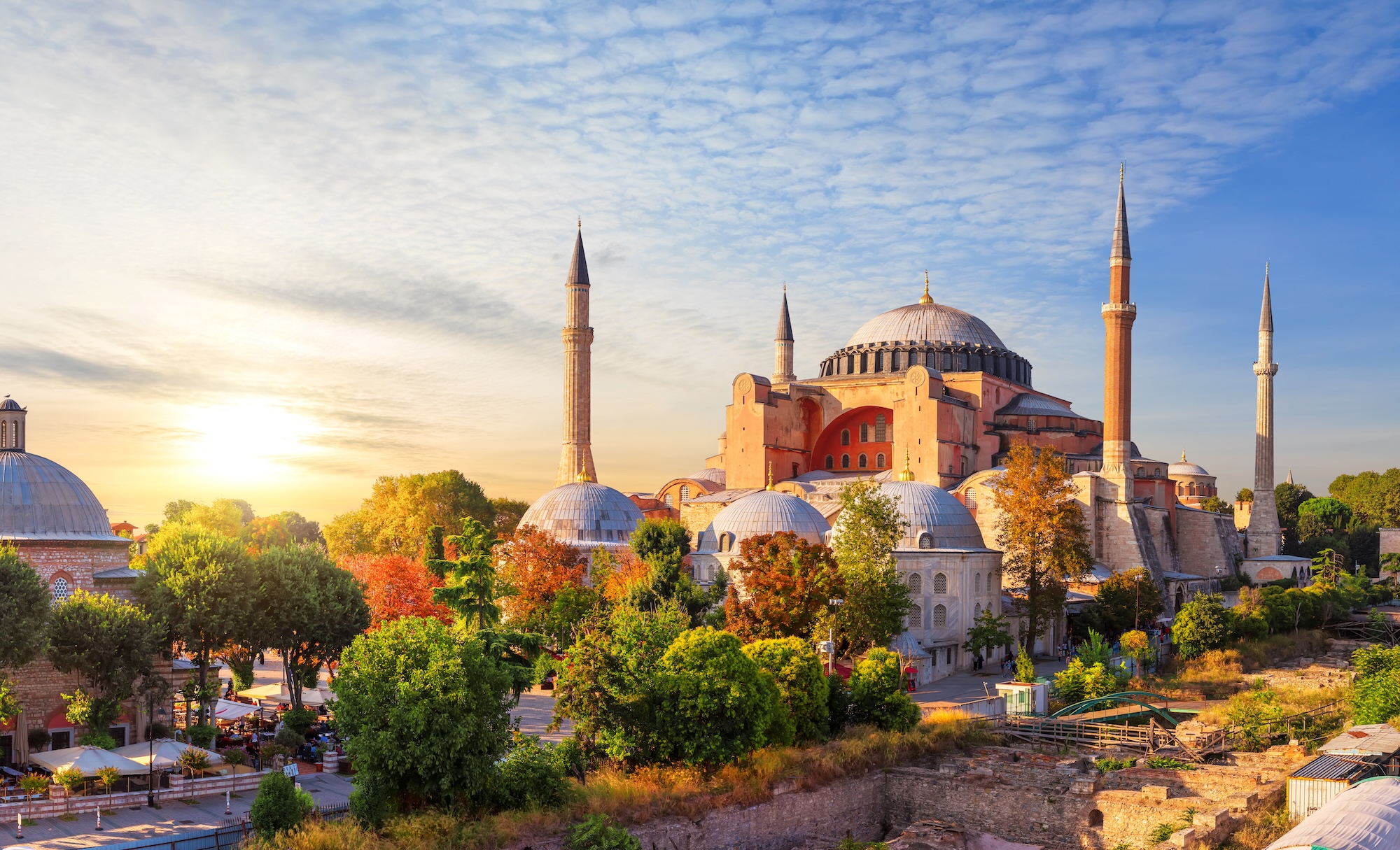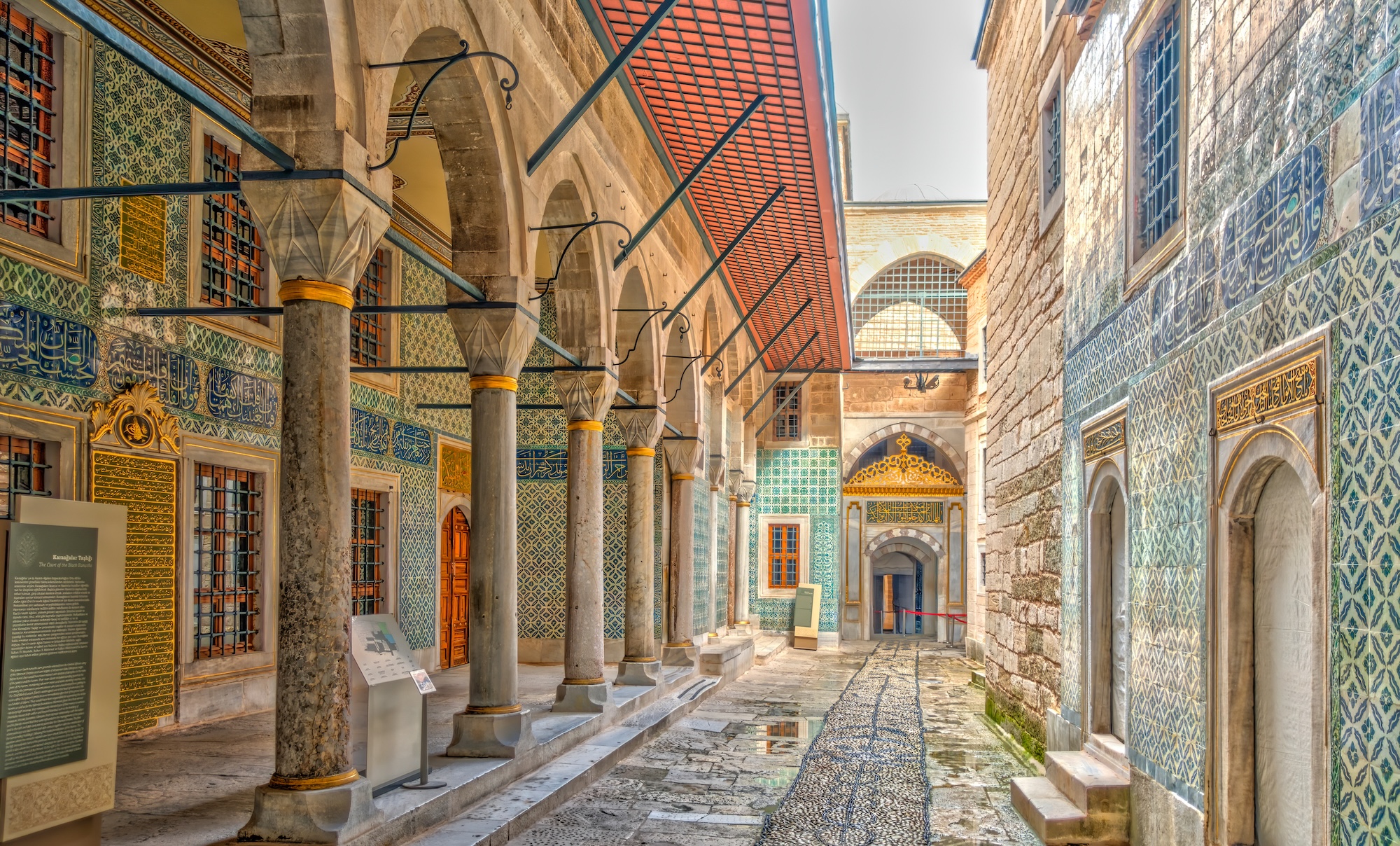
World Travel Tips
What Should You Do in Istanbul?
Istanbul, a city that spans two continents, is a treasure trove of history, culture, and breathtaking sights. From grand mosques to ancient palaces and lively markets, this vibrant metropolis offers something for every traveler. Below are ten of the top attractions that you shouldn’t miss when visiting Istanbul.
1. Hagia Sophia

Once a Byzantine cathedral, later an Ottoman mosque, and now a museum, the Hagia Sophia is one of Istanbul’s most famous landmarks. This majestic building is a masterpiece of architecture, with its enormous dome, intricate mosaics, and grand interior. The Hagia Sophia’s unique fusion of Christian and Islamic artistry reflects Istanbul’s rich cultural and religious history.
Why visit?
Hagia Sophia offers an extraordinary opportunity to explore the blend of Christian and Islamic heritage in one awe-inspiring structure. Its historical significance and architectural beauty make it a must-visit for anyone in Istanbul.
2. The Blue Mosque (Sultan Ahmed Mosque)

The Blue Mosque, one of Istanbul’s most iconic structures, is renowned for its stunning blue tiles that adorn the interior. This working mosque, with its six minarets and impressive courtyard, is an active place of worship and a significant example of Ottoman imperial architecture.
Why visit?
The Blue Mosque is a masterpiece of Islamic architecture, and visiting it allows you to experience the spiritual heart of Istanbul. The beauty and serenity of the mosque, along with its historical importance, make it a must-see.
3. Topkapi Palace

Once the residence of Ottoman sultans, Topkapi Palace is now a museum showcasing the opulence and grandeur of the Ottoman Empire. Visitors can explore lavish courtyards, royal chambers, and the famous Harem, all filled with priceless treasures and artifacts.
Why visit?
Topkapi Palace offers an in-depth look into the luxurious lifestyle of the Ottoman rulers. The palace’s historical significance, beautiful gardens, and incredible collections make it a captivating destination for history and culture lovers.
4. Basilica Cistern
Hidden beneath the streets of Istanbul, the Basilica Cistern is an ancient underground water reservoir built by Emperor Justinian I in the 6th century. Visitors can wander through its eerie corridors, lined with columns and lit by soft lighting, creating a mesmerizing atmosphere.
Why visit?
The Basilica Cistern is a unique and atmospheric experience. It offers a glimpse into ancient engineering and a chance to explore a lesser-known but fascinating part of Istanbul’s history.
5. Grand Bazaar
One of the largest and oldest covered markets in the world, the Grand Bazaar is a labyrinth of more than 4,000 shops offering everything from spices and textiles to jewelry and antiques. It’s an essential stop for those looking to experience Istanbul’s vibrant market culture.
Why visit?
The Grand Bazaar is a sensory overload and an iconic part of Istanbul’s cultural fabric. It’s perfect for shopping, people-watching, or simply getting lost in its maze of colorful stalls.
6. Galata Tower
Standing tall in the Beyoğlu district, Galata Tower offers panoramic views of Istanbul’s skyline, the Bosphorus, and the Golden Horn. Originally built as a watchtower in the medieval era, it now serves as a popular tourist attraction.
Why visit?
The views from the top of the Galata Tower are some of the best in Istanbul. Whether you’re interested in photography, sightseeing, or just enjoying the vistas, this landmark offers an unforgettable perspective of the city.
7. Dolmabahçe Palace
This stunning palace, located along the Bosphorus, was the administrative center of the late Ottoman Empire and the home of the sultans in the 19th and early 20th centuries. The palace combines European architectural styles with traditional Ottoman elements and features lavish interiors, including a massive crystal chandelier.
Why visit?
Dolmabahçe Palace offers an opulent glimpse into the late Ottoman Empire. Its grandeur and beautiful location on the Bosphorus make it a must-visit for those interested in royal history and architecture.
8. Bosphorus Cruise
A Bosphorus cruise is one of the best ways to see Istanbul from the water. The Bosphorus Strait divides the European and Asian sides of the city, and a boat trip along this iconic waterway gives you unparalleled views of Istanbul’s palaces, bridges, and historic landmarks.
Why visit?
The Bosphorus cruise provides a unique vantage point of the city, offering stunning views of both the European and Asian shores of Istanbul. It’s a relaxing and scenic way to experience the city’s beauty.
9. Istanbul Archaeology Museums
Located near Topkapi Palace, the Istanbul Archaeology Museums are home to one of the most extensive collections of ancient artifacts in the world. The museums feature treasures from ancient civilizations, including Greek, Roman, and Egyptian artifacts, along with an impressive collection of Islamic art.
Why visit?
For history buffs, the Istanbul Archaeology Museums are a treasure trove of ancient artifacts. The collections are vast and varied, providing a fascinating glimpse into the civilizations that have shaped this region.
10. Taksim Square and Istiklal Avenue
Taksim Square is the heart of modern Istanbul, a bustling hub surrounded by shops, restaurants, and theaters. From the square, you can walk down Istiklal Avenue, a lively pedestrian street lined with boutiques, cafes, and cultural landmarks.
Why visit?
Taksim Square and Istiklal Avenue offer a vibrant and energetic experience of Istanbul’s modern side. It’s the perfect place to enjoy shopping, dining, and people-watching while soaking in the city’s lively atmosphere.
Seasonal Recommendations
☀️ Summer (June–August): Summer is the peak tourist season in Istanbul, with long days, high energy, and a constant buzz in the streets. Temperatures typically range from 25°C to 35°C (77°F to 95°F), and while it can get hot, the city’s vibrant atmosphere is hard to resist. Outdoor cafés overflow, Bosphorus cruises are in full swing, and the historic Sultanahmet area is bustling. It’s a great time to enjoy evening visits to open-air landmarks like the Hagia Sophia and Blue Mosque, which look stunning under the golden light. Just be prepared for crowds and higher prices.
🌸 Spring (April–May): Spring is one of the best times to experience Istanbul with mild temperatures ranging from 12°C to 25°C (54°F to 77°F), blooming tulips, and fewer crowds than summer. The city feels fresh and colorful, and it’s perfect for leisurely walks through parks, the historic neighborhoods, or along the Bosphorus. It’s also an ideal time to explore iconic sites like the Topkapi Palace or the cool underground of the Basilica Cistern without the summer rush.
🍁 Autumn (September–November): Fall is another sweet spot for visitors. With temperatures ranging from 15°C to 28°C (59°F to 82°F), the weather remains pleasant, and the summer crowds begin to thin. The city takes on a romantic atmosphere, especially in the early evenings. It’s a great time to enjoy panoramic views from Galata Tower or explore the bustling alleys of the Grand Bazaar at a more relaxed pace. Cultural events also start picking up again in the fall.
❄️ Winter (December–March): Winter is the quietest season for tourism in Istanbul, but that comes with perks—fewer lines, lower hotel rates, and a calm, local vibe. Temperatures range from 3°C to 12°C (37°F to 54°F), and while it can be chilly and occasionally snowy, the city’s rich indoor experiences make it worthwhile. Warm up inside the Istanbul Archaeology Museums or admire the grandeur of Dolmabahçe Palace. Cozy cafés, Turkish baths, and festive lights around Taksim Square add a charming touch to the cooler months.
Istanbul Excursions
Tips for Your Visit
Getting Around:
- Use Istanbul’s extensive public transportation network, including trams, ferries, and the metro, to easily navigate the city. The Istanbulkart is a convenient, rechargeable card for all public transport.
- Taxis are available, but ensure the meter is running or agree on a price beforehand to avoid overcharging.
Local Cuisine:
- Don’t miss classic Turkish dishes like kebabs, mezes, baklava, and Turkish delight. Street food like simit (sesame bagels) and fish sandwiches near the Galata Bridge are also popular.
- Be sure to sip on Turkish tea or coffee—an essential part of the local culture.
Language:
- While Turkish is the official language, many people working in tourist areas speak English. Learning a few basic phrases in Turkish (like “Merhaba” for hello) can go a long way in showing respect to the locals.
Safety:
- Istanbul is generally safe for tourists, but like any big city, be cautious in crowded areas or when using public transportation, especially with your belongings.
- Stay aware of your surroundings and avoid isolated areas late at night, particularly around less-populated parts of the city.
3 Popular Restaurants
Istanbul is a culinary haven where traditional Turkish flavors blend with innovative international influences, making it a city of endless dining possibilities. Whether you’re in the mood for an unforgettable steakhouse experience, a contemporary fine dining adventure, or a taste of authentic Anatolian cuisine, Istanbul has something to offer. Below are three of the most popular and iconic restaurants in the city that promise not only delicious food but also unique experiences.
1. Nusr-Et Steakhouse
Location: Etiler, Nisbetiye Cd No:87, 34337 Beşiktaş/İstanbul, Türkiye View On Map
Cuisine: Steakhouse / Turkish BBQ
Why It’s Popular: Nusr-Et Steakhouse, owned by the world-famous Turkish chef Nusret Gökçe (aka “Salt Bae”), has become a global phenomenon. Its popularity skyrocketed after Nusret’s viral “salt sprinkling” video, and it’s now a must-visit spot for meat lovers in Istanbul. The restaurant offers top-tier cuts of meat, from tender steaks to juicy burgers, all expertly prepared and served with dramatic flair by the staff. With locations worldwide, Nusr-Et has turned dining into an experience—making every meal a performance as well as a feast.
What Makes It Stand Out: The combination of high-quality meats, theatrical presentations (especially Nusret’s signature salt-sprinkling), and a celebrity status has made Nusr-Et a unique and unforgettable dining experience. The luxurious setting, combined with impeccable service, adds to the exclusivity of this restaurant.
2. Mikla
Location: The Marmara Pera, Asmalı Mescit, Meşrutiyet Cd. No:15, 34430 Beyoğlu/İstanbul, Türkiye View On Map
Cuisine: Contemporary Turkish / Scandinavian
Why It’s Popular: Mikla, perched on the 18th floor of the Marmara Pera Hotel, offers stunning views of Istanbul and is widely regarded as one of the best fine dining experiences in the city. Chef Mehmet Gürs combines contemporary Turkish ingredients with Scandinavian influences, creating dishes that are innovative yet deeply rooted in the country’s culinary traditions. Mikla’s refined atmosphere, elegant plating, and exceptional service make it a favorite among locals and visitors alike.
What Makes It Stand Out: Mikla’s fusion of Turkish and Scandinavian flavors, paired with its unparalleled views of Istanbul’s skyline and Bosphorus, creates a dining experience that’s both extraordinary and memorable. Its modern twist on classic Turkish cuisine and the Michelin Guide’s recognition further solidifies its place at the top.
3. Çiya Sofrası
Location: Caferağa, Güneşli Bahçe Sok, 34710 Kadıköy/İstanbul, Türkiye View On Map
Cuisine: Traditional Turkish / Anatolian
Why It’s Popular: Located in the Kadıköy district on the Asian side of Istanbul, Çiya Sofrası offers an authentic dive into the diverse and often underappreciated flavors of Anatolian cuisine. The restaurant is known for its extensive menu that highlights regional dishes from all over Turkey, many of which are hard to find elsewhere. From kebabs to hearty stews and unique vegetarian dishes, Çiya Sofrası has become a beloved institution for food enthusiasts looking to explore the true breadth of Turkish culinary heritage.
What Makes It Stand Out: What sets Çiya Sofrası apart is its dedication to preserving and presenting lesser-known regional Turkish dishes. Its warm, inviting atmosphere and the use of locally sourced ingredients make it an essential stop for anyone looking to experience traditional Turkish flavors beyond the standard fare.
Tips for Dining in Istanbul
Istanbul’s food scene is as vibrant and diverse as the city itself. From bustling street food stalls to elegant restaurants offering panoramic views of the Bosphorus, dining in Istanbul is an unforgettable experience. If you’re planning to explore the city’s rich culinary offerings, here are some tips to help you navigate the flavors, etiquette, and unique dining culture of Istanbul.
1. Try Street Food – It’s Part of the Experience!
Istanbul’s street food is iconic and should be at the top of your list. Vendors are found everywhere, from major squares to tucked-away alleyways. Some must-tries include:
- Simit: A sesame-crusted bread similar to a bagel, often eaten as a snack or breakfast.
- Balık Ekmek: A fish sandwich, usually served from boats along the Galata Bridge or the Golden Horn.
- Köfte: Turkish meatballs, typically served with flatbread or in a sandwich.
- Dondurma: Turkish ice cream, known for its stretchy texture and often served with a playful show by the vendor.
Tip: Street food is generally very affordable and a great way to immerse yourself in local life. Be sure to try a few different items during your trip!
2. Expect a Meal to Be a Social Affair
In Turkey, dining is a social event, and meals are often shared among friends and family. It’s common to order multiple mezes (small appetizers) to share, and each dish is an opportunity to savor different flavors.
Tip: If you’re invited to a local’s home, be sure to try everything offered, and don’t rush—Turkish meals can last for hours with lively conversation and multiple courses. Also, it’s polite to try a little bit of everything.
3. Order Like a Local: Mezze and Kebabs
A traditional Turkish meal typically starts with a selection of mezze—small, flavorful appetizers such as hummus, baba ganoush, stuffed grape leaves, and yogurt-based dips. Follow it up with a main dish, usually featuring grilled meats like kebabs, lamb, or köfte.
Tip: If you’re visiting a lokanta (a casual Turkish restaurant), ordering a few meze and one main dish is the typical way to go. Pair it with a side of pilav (rice) or şiş (grilled meat skewers) for a complete meal.
4. Don’t Miss the Turkish Breakfast (Kahvaltı)
Turkish breakfasts are famous for being elaborate and delicious. A traditional kahvaltı includes a variety of cheeses, olives, honey, tomatoes, cucumbers, eggs, bread, and, of course, Turkish tea. It’s an important meal, often enjoyed leisurely over hours, particularly on weekends.
Tip: If you’re staying at a hotel, consider seeking out a local café for an authentic breakfast experience. Many places offer extensive breakfast spreads, where you can sample a variety of dishes at once.
5. Turkish Tea and Coffee – Sip Slowly, Enjoy the Moment
Turkish tea (çay) is an integral part of daily life, and you’ll find it served in small tulip-shaped glasses throughout the day. It’s typically consumed without milk and enjoyed with sweets or pastries.
Turkish coffee is equally iconic and is known for its strong, rich flavor. It’s served in small cups, often accompanied by a glass of water and a piece of Turkish delight (lokum).
Tip: When enjoying Turkish coffee, allow the grounds to settle at the bottom of the cup before drinking. If you’re interested, many cafés offer “fortune-telling” services, where a barista interprets the patterns left by the coffee grounds!
6. Know the Etiquette: Punctuality and Generosity
While Turkish people are known for their hospitality, there are a few dining etiquettes to keep in mind:
- Punctuality: Being on time for a meal is appreciated, but it’s common to start a little later than the stated time, especially for evening meals.
- Generosity: If you’re invited to a Turkish home, it’s customary to accept an offer of food or drink. Hosts take pride in offering their guests more than enough food, so don’t be surprised by the abundance on your table!
Tip: If you’re not sure how much to eat, follow the lead of your host or other diners. When it comes to desserts, it’s considered polite to accept at least a small portion.
7. Water Is Not Always Free
In many restaurants, especially the more touristy spots, bottled water is often served as part of the meal, and there may be a charge for it. Tap water is generally safe to drink, but it’s always a good idea to ask for bottled water if you’re unsure.
Tip: Always ask for tap water if you want to avoid paying for bottled water. Also, if you’re dining at a high-end restaurant, the water charge may be separate from the meal cost, so be aware of that when reviewing the bill.
8. Tipping Is Appreciated, but Not Always Expected
Tipping is appreciated in Istanbul but not obligatory. In casual eateries, tipping around 5-10% is customary, though many locals round up the bill or leave small change. In upscale restaurants, a tip of 10-15% is more common.
Tip: If the service is exceptional, feel free to leave a larger tip. In many smaller, family-run restaurants, the staff may be pleasantly surprised by your generosity.
9. Explore the Variety of Regional Cuisines
Istanbul’s culinary scene reflects the diverse regions of Turkey. Be sure to explore dishes from different parts of the country, like mantı (Turkish dumplings) from the Central Anatolia region, or künefe (a sweet dessert) from Hatay.
Tip: If you’re looking to branch out from the usual kebab fare, try visiting a regional restaurant that specializes in a specific type of Turkish cuisine. The variety will surprise you!
10. Vegetarian-Friendly Options
Turkish cuisine offers a wealth of vegetarian-friendly dishes, such as falafel, imam bayıldı (stuffed eggplant), çörek (savory pastries), and fresh vegetable mezes.
Tip: If you’re a vegetarian, don’t hesitate to ask for a meat-free version of any dish, as Turkish chefs are often happy to accommodate dietary preferences.
Final Thoughts
Dining in Istanbul is more than just about food—it’s an experience steeped in tradition, flavor, and warmth. Whether you’re grabbing a quick bite at a street stall or savoring a multi-course feast, Istanbul’s culinary scene will captivate you. Just remember to eat like a local, embrace the social nature of meals, and enjoy every delicious moment in this vibrant city!









